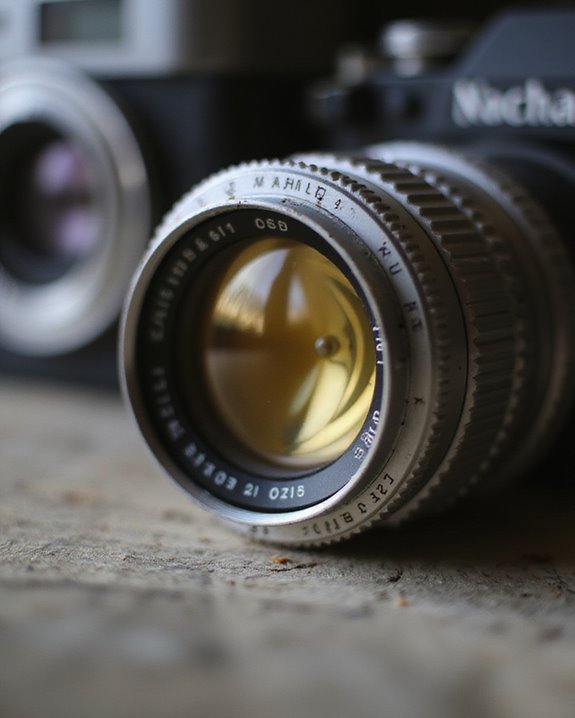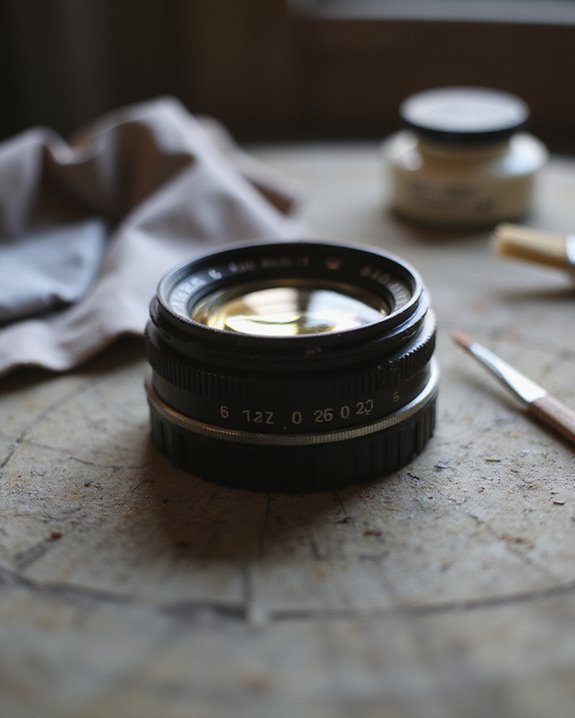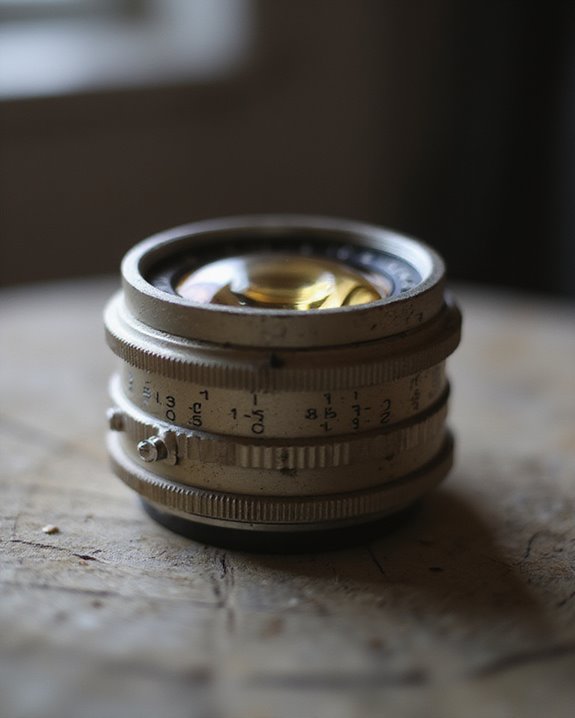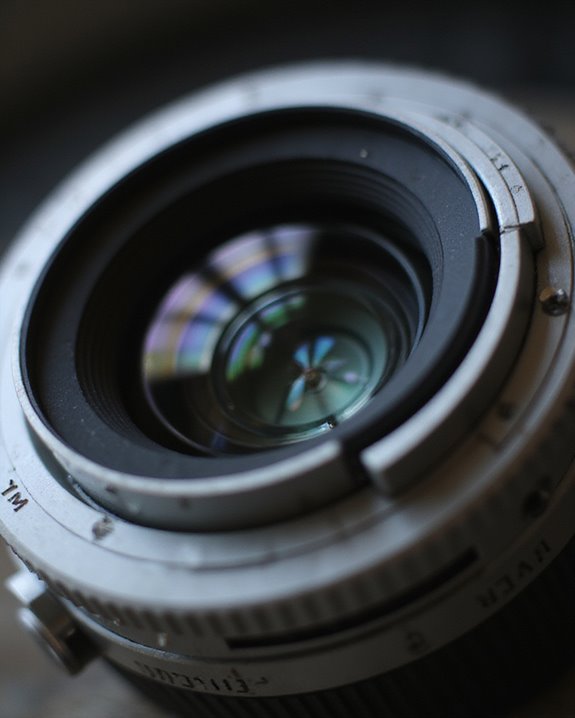Old camera lenses develop yellow coloration primarily due to radioactive thorium oxide used in vintage optical glass formulations. This compound, added to increase refractive index and reduce chromatic aberration, undergoes radioactive decay over decades. The decay creates color centers called F-centers, which absorb blue light and shift the visible spectrum toward yellow-brown hues. Environmental factors like heat and humidity accelerate this degradation process. Understanding these mechanisms reveals potential restoration methods for affected vintage equipment.
Key Takeaways
- Thorium oxide in vintage lens glass undergoes radioactive decay, creating color centers that absorb blue light.
- Alpha particles emitted during decay form F-centers that cause a yellow-brown tint over decades of use.
- Environmental factors like heat, humidity, and UV exposure accelerate the yellowing process in older lenses.
- Vintage lenses contained up to 30% thorium by weight to improve optical properties but sacrificed long-term clarity.
- Yellowing results from cumulative radiation exposure proportional to the lens age, affecting overall image quality.
The Science Behind Lens Yellowing
The yellowing phenomenon observed in vintage camera lenses stems primarily from their unique material composition, which often included radioactive elements to enhance optical performance. Specifically, thorium oxide and lanthanum compounds were incorporated into glass formulations from the 1950s through 1970s to achieve higher refractive indices, enabling superior optical designs. Over decades, these elements undergo radioactive decay, emitting alpha and beta particles that disrupt the molecular structure of the glass. This radiation creates color centers that absorb blue light wavelengths, resulting in noticeable Spectral Shifts toward yellow-brown hues. Environmental factors and impurities can accelerate these oxidation effects, further degrading glass clarity through chemical processes. The cumulative damage increases proportionally with the lens age, as more radiation exposure progressively alters the internal glass matrix. Additionally, the presence of radioactive materials in some vintage lenses can pose health risks if not handled properly.
Radioactive Elements in Vintage Lenses

Why did manufacturers deliberately incorporate radioactive materials into camera lenses? During the mid-20th century, lens makers discovered thorium oxide‘s exceptional optical properties, which reduced chromatic aberration while allowing for less curved, more affordable lens designs. Some formulations contained up to 30% thorium by weight, producing glass with superior light transmission and sharpness compared to conventional materials. These radioactive elements also contributed to the yellow coloration that characterizes many vintage lenses today.
Radiation safety concerns remained minimal since the alpha particles emitted by thorium are effectively blocked by the lens barrel and cannot penetrate skin. However, these materials cause the distinctive yellowing seen in vintage lenses through the formation of F-centers—displaced electrons that absorb blue light. Thorium disposal presents challenges for collectors; while exempt from most regulations during normal use, damaged radioactive lenses should be properly labeled as radioactive waste when discarded.
How Thorium and Lanthanum Affect Glass Over Time

Understanding how thorium and lanthanum affect glass over time reveals the fascinating chemistry behind vintage lens yellowing. The radioactive decay of thorium dioxide, which once comprised up to 30% of lens glass by weight, creates F-centers that manifest as yellow or brown discoloration, greatly altering the glass’s color neutrality and optical performance. While thorium substantially impacts glass durability through this discoloration process, lanthanum oxide contributes differently to elemental stability, enhancing alkali resistance without significant radioactive effects. The 99.9% non-radioactive lanthanum provides optical benefits without the long-term degradation associated with thorium. Over decades, thorium-containing lenses progressively yellow, though this can be partially reversed through annealing or UV exposure. Modern lens manufacturing has largely abandoned thorium in favor of safer alternatives, including lanthanum-based compounds that maintain superior optical properties without sacrificing long-term clarity. Elemental stability plays a crucial role in the development of modern optical glass, reducing reliance on radioactive materials.
Impact of Yellowing on Photography Results

When photographic lenses develop their characteristic yellow tint over time, the impact on resulting images extends far beyond mere aesthetics, affecting critical technical aspects of photography. The most immediately noticeable consequence is a significant Color Shift, with photographs exhibiting a uniform yellowish cast that particularly affects bright scenes and can alter the natural appearance of skin tones and skylines.
Yellowing introduces notable Contrast Effects, generally reducing the dynamic range between highlights and shadows, resulting in images that appear softer and less defined. Unlike intentional yellow filters used in black and white photography to enhance certain elements, lens yellowing typically flattens the overall image quality by diminishing light transmission efficiency. Some photographers, however, deliberately leverage these characteristics to achieve vintage aesthetics in their work, embracing the unique color properties that yellowed lenses impart to create nostalgic or period-appropriate visual narratives.
UV Light Treatment: Reversing the Yellow Tint

The yellowing effect that plagues vintage camera lenses isn’t necessarily permanent, as UV light treatment offers photographers a promising method for reversing this common age-related discoloration. Both UV-A/B and UV-C light sources can effectively reduce yellowing by altering the molecular structure of affected glass elements, with UV-C providing superior penetration for deeply tinted lenses. Ideal results typically require several hours to days of exposure, enhanced by reflective materials like aluminum foil or mirrors to guarantee complete coverage.
Several Safety Concerns warrant consideration during treatment, including potential overheating damage to lens coatings and incompatibility with certain glass formulations. Future Innovations in this restoration technique may include specialized LED arrays with precise wavelength targeting and temperature-controlled exposure chambers, potentially offering more consistent results with reduced risk of collateral damage.
DIY Restoration Methods for Yellowed Lenses

Amateur photographers and vintage camera enthusiasts can successfully combat lens yellowing through several accessible DIY restoration methods that don’t require professional intervention. UV light exposure remains the most effective technique, with many collectors using home UV lamps or even directed sunlight to gradually reverse the yellowing process. Proper preparation, including thorough cleaning and careful handling, greatly improves restoration outcomes while minimizing potential damage to delicate glass elements.
Some photographers employ alternative approaches such as the Lens Buffing technique for surface-level discoloration, carefully polishing external elements with appropriate compounds. The Baking Method, though controversial among purists, involves controlled heat exposure to accelerate the restoration process. Regardless of the chosen method, photographers should monitor progress regularly, as complete restoration may require several days of treatment depending on the severity of yellowing.
Identifying Lenses Prone to Yellowing

Nearly all vintage camera enthusiasts can benefit from learning to identify lenses that are prone to yellowing before making a purchase or restoration commitment. Visual inspection remains the most accessible method, as markedly yellowed lenses will show discoloration when held against a white background. For more definitive identification of radioactive elements, which commonly cause yellowing, a Geiger counter provides conclusive evidence of Thorium or Lanthanum content in the glass.
Lens cleaning history can reveal susceptibility to yellowing, as accumulated grease often penetrates lens surfaces and accelerates discoloration. Storage effects also play a critical role, with lenses previously exposed to high UV levels, excessive heat, or humidity showing greater yellowing potential. Checking the lens material specifications and manufacturing date can further identify compositions particularly vulnerable to environmental degradation over time.
Historical Manufacturing Practices in Optics

Historical manufacturing practices in optics evolved dramatically from ancient times through the modern era, fundamentally shaping the materials and techniques that contributed to lens yellowing in vintage cameras. Early lens makers primarily relied on optical grinding techniques developed by craftsmen like Chevalier and Zeiss, who meticulously worked with crown and flint glass to create achromatic lenses. The lens polishing processes, while advanced for their time, lacked modern quality controls that would have prevented impurities from entering the optical glass.
Preserving Vintage Lenses: Best Practices

Preserving vintage lenses requires dedicated, systematic care to prevent deterioration and maintain their unique optical characteristics, regardless of the yellowing that may have occurred over time. Proper humidity control stands as a critical factor in lens preservation, with experts recommending storage in cool, dry environments supplemented with silica gel packets to prevent moisture accumulation that leads to fungal growth. Lubricant maintenance represents another essential aspect of vintage lens care, as improper storage can cause oils to migrate onto aperture blades or optical elements.
For best preservation, store lenses upright with front elements down when appropriate, keep them away from direct sunlight, and use original cases and caps whenever possible. Regular inspection and gentle cleaning with non-abrasive materials help maintain both the optical quality and collector value.
Frequently Asked Questions
Can Yellowed Lenses Cause Health Concerns Due to Radioactivity?
Golden glass hides negligible risks. Thorium exposure from yellowed lenses poses virtually no health concerns during normal use. Radiation myths exaggerate dangers, as alpha particles remain trapped inside glass and gamma radiation levels are below background sources.
Does Lens Yellowing Occur in Modern Lenses Manufactured Today?
Modern lenses rarely yellow due to significant material advances. Contemporary manufacturing eliminates radioactive elements and incorporates UV filters and stabilizers that prevent the formation of color centers in optical glass components.
How Does Temperature and Storage Environment Affect Yellowing Progression?
Ever wonder how your storage choices impact lens yellowing? Higher temperatures accelerate discoloration while cool, dark environments slow it. Humidity effects can worsen appearance, and proper storage materials can minimize yellowing by preventing environmental damage.
Are There Professional Services That Specialize in Vintage Lens Restoration?
Numerous professional services specialize in vintage lens restoration, employing sophisticated restoration techniques from disassembly to recalibration. These specialists often adhere to industry certification standards while restoring optics for brands like Leica and Hasselblad.
Does Yellowing Affect Different Photography Genres (Portraits, Landscapes) Differently?
Yellowing impacts genres distinctively: portrait effects benefit from warmer tones enhancing skin tones, while landscape tones suffer from color inaccuracy and compromised natural blues and greens. Different photographers value these characteristics variably.





